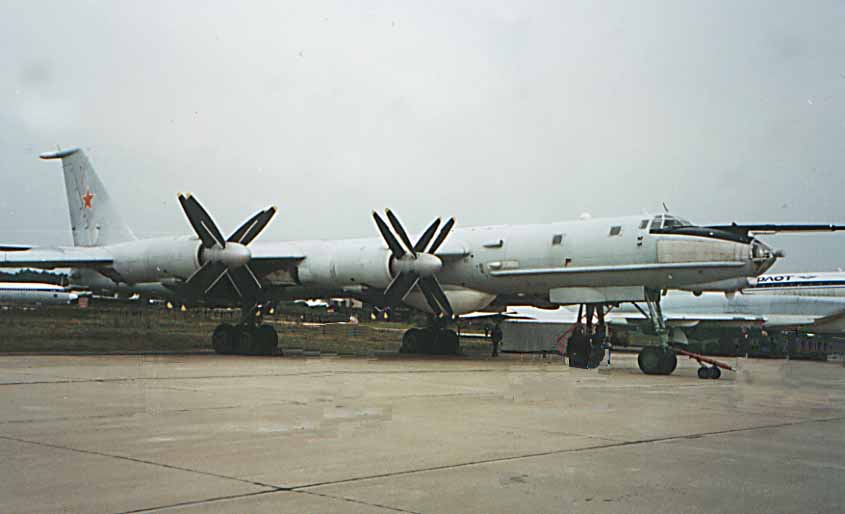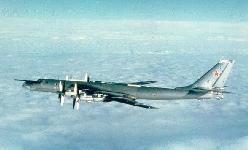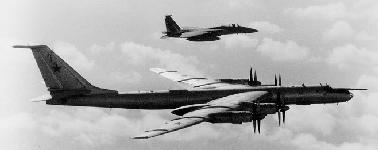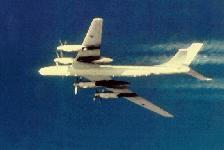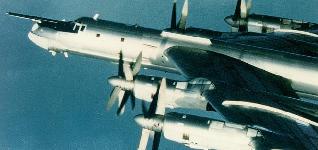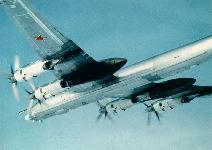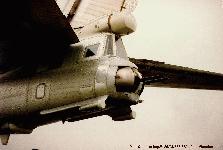|
Air Power |
The Tu-95 BEAR was perhaps the most successful bomber produced by the Soviet aviation, enjoying long service in a variety of roles and configurations. It was the only bomber deployed by any country to use turbo-prop engines, which provided extraordinarily long endurance at speeds only slightly less than comparable turbojet-powered heavy bombers.
Development of the TU-95 intercontinental bomber began in the early 1950s after series production of the medium-range TU-4 started.. Initially, several designs were considered, including a modification of the TU-4 and production of a new aircraft with piston engines. Prototypes of these aircraft were developed and tested from 1949 through 1951, it was concluded that bombers with piston engines could not provide adequate performance for the intercontinental attack mission. In March 1951 development of the T-4 intercontinental jet bomber began. However, KB Tupolev did not support the development of a bomber with turbojet engines, believing that the proposed AM-3 jet engines would not provide for the required range of more than 10,000 km. As an alternative, KB Tupolev proposed an aircraft with four turbo-prop engines that would provide a range of more than 13,000 km and speeds of more than 800 km/h at altitudes of 10,000 meters. The aircraft-design was designated as "95".
The design of the wings drew heavily on the experience gathered by Tupolev and the Central Aerohydrodynamic Institute (TSAGI) during the development of the swept wing TU-16. The wings of the "95" were swept back at an angle of 35 degrees, allowing the placement of a large bomb bay behind of the torsion box of the wings' central unit at the aircraft's center of gravity.
The Bear's wings are mid-mounted, swept-back, and tapered with blunt tips. Its engines consist of four turboprops with contrarotating propellers located on the wings. The engine nacelles extend well beyond the wings’ leading edges. The fuselage of the Bear is tube-shaped with a rounded nose that tapers to the rear. It also has a stepped cockpit and a tail gun compartment. The tail of the aircraft is a fin that is swept-back and tapered with a square tip.
The greatest difficulties during the development were the engines. After studies on different engine combinations and versions, the final design of the aircraft incorporated four turbo-prop engines with a thrust of about 10,000-shp. In the late 1940s, the most powerful turbo-prop engine available was the BK-2 prototype which had significantly less thrust (4800-shp). In the early 1950s OKB-276 N.A. Kuznetsov developed the TV-2 engine and the TV-2F booster engine with a thrust of 6,250-shp. while work on the TV-12 engine with sufficient thrust for the "95" aircraft continued.
After consideration of Tupolev's proposals, on 11 July 1951 the government officially approved the development of the "95" aircraft: Two versions were built, one with eight TV-2F engines coupled through the reduction gearbox in four pusher-tractor tandem pairs, and a second version with four TV-12 engines. N.I. Bazenkov became the chief designer of all subsequent TU-95 versions. When he died in 1975, N.V. Kursanov took over as chief designer, and from the end of the 1980s, D.A. Antonov became head of the program.
In 1952, the first prototype "95/1", equipped with 8 2TV-2F engines, was built at Plant Nr. 156. The reduction gearbox and the four-blade contra-rotating propellers were developed by OKB-120 headed by K.N. Zhdanov. Each pair generated a thrust of 12,000-shp. The first flight of the "95/1" airplane took place on 12 November 1952, but on 11 May 1953 during its' 17th flight the plane crashed and burned due to an engine fire. The second prototype ("95/2"), equipped with TV-12 engines, was completed in June 1954 with a first flight on 16 February 1955. During tests, while carrying a load of 5000 kg, it reached a range of about 15,000 km, a speed of 993 km/h and a ceiling of 11,300 m. Series production of the aircraft -- now designated as TU-95 -- started in January 1956 at Plant Nr. 18 in Kuibyshev, while production tests were still underway.
When the START-1 treaty was signed in 1991, 147 bombers and missile carriers still served in the Russian forces: 84 TU-MS and 63 TU-95K-22, TU-95K and TU-95M. An additional 11 TU-95U were used for training.
After the dissolution of the Soviet Union, one unit of Bear aircraft remained in Ukraine, with twenty three TU-95MS, one TU-95K and one TU-95M aircraft. These aircraft were passed to Ukraine, and were subject to decommissioning under the provisions of the START-1 treaty. A total of 11 strategic bombers and 600 air-launched missiles exchanged by Ukraine to Russia in payment for the gas debt were transfered in mid-February 2000. Two Tu-160 bombers flew from Priluki in the Ukrainian Chernigov region for the Russian air base in Engels. The missiles were sent to Russia by railroad. Three Tu-95MS bombers and six Tu-160 airplanes had already arrived at Engels since October 1999 in fulfilment of the intergovernmental agreements. Before being moved to Russia, 19 Tu-160 airplanes were stationed at the Priluki airfield and 21 Tu-95MS were located in Uzin.
At the time of the breakup of the Soviet Union, thirteen TU-95MS-16 and twenty seven TU- 95MS-6 were based in Kazakhstan. Subsequently, all Bear aircraft located in Kazakhstan were transferred to Russia.
Russian Tu-95 and TU-95MS aircraft are now deployed at two air bases A total of nineteen TU-95MS16 and two TU-MS6, operating in the 121st heavy bomber air regiment, which forms part of the 22nd Air Division that is headquarteed in Engels Air Base in the Moscow region. At the Ukrainka airbase (73th Heavy Bomber Air Division) at Svobodny, there are 16 TU-95MS16 and 26 TU-95MS6 bombers that were redeployed from the Dolon airbase at Semipalatinsk in Kazakhstan. The TU-95K-22 bombers are subject to decommisioning. In early 1997 five TU-95K-22 were decommissioned and re-equipped in Zngyelse, and five at the Ryazan training center. Eight TU-95 are located at the flight-test institute in at Zhukovskiy [Ramenskoye], and one TU-95K aircraft serves as a static display in Ryazan.
The TU-95MS, constructed in in the middle and early 1990s, will be operational until 2010 and 2015. Russia is currently working on a new air-to-surface missile to replace the existing Kh-55.
In late June 1999 two TU-95 Bear bombers flew within striking distance of the United States as part of Moscow's largest military exercises since the end of the Cold War. The bombers were intercepted by four US F-15 fighters and a P-3 patrol plane near Iceland and escorted in a clockwise flight around the island. The Bears, and two Blackjacks, were from the Donbass Red Banner 22nd heavy bomber division based at Engels Air Base east of Moscow. They initially flew acoss the central Norwegian Sea. When they got about halfway across, the Blackjacks split off from the Bears and flew along the Norwegian coastline.
On 16 September 1999 a pair of Russian Tu-95 Bear bombers were detected by the US Air Force headed toward the Alaska coast. U.S. fighter jets were sent to intercept the aircraft which had been caught on radar. Air Force officials said both bombers turned before crossing into US airspace and about 90 miles from the approaching fighters. The Soviet Union regularly tested U.S. air defenses by flying toward Alaska during the Cold War, but this was the first time the Air Force had documented it happening since March 1993
Specifications:
Primary Function: Multi-role strategic aircraft
Contractor: Tupolev Design Bureau
Powerplant: Four Kuznetsov NK-12MV turboprops, 14,795 shp each
Crew: Eight
Dimensions:
Length: 162 ft 5 in (49.5 m)
Wingspan: 167 ft 8 in (51.1 m)
Height: 39 ft 9 in (12.12 m)
Empty: 198,415 lb
Maximum Takeoff: 414,470 lb
Performance:
Speed: 575 mph (925 km/h)
Ceiling: 39,370 ft (12000 m)
Range: 7,800 miles (12,550 km)
Armaments:
Up to Six Am-23 (23mm) guns in up to 3 installations
Up to 16 cruise missiles
Various conventional and nuclear bombs up to 12.000kg total load.
All photos Copyright of Federation of American Scientists
